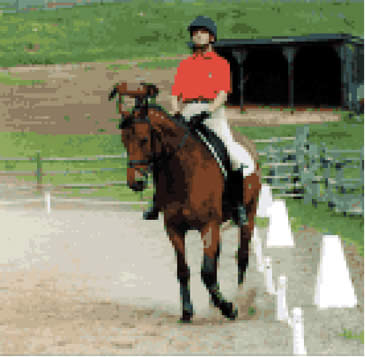Shoulder-in is the father of all the advanced lateral exercises. What I mean by advanced lateral exercises are exercises like shoulder-in, haunches-in, half pass, walk pirouettes, and canter pirouettes.
Shoulder-in does a lot of different things. It is a straightening exercise, a strengthening of the inside hind leg exercise, and a collecting exercise. The quality that makes shoulder-in a collecting exercise is that your horse must bend while he goes sideways. If your horse isn’t bending from poll to tail then your shoulder-in becomes a leg yield. That’s fine if you want to do a leg yield. But if you want to collect your horse–meaning you want to load the hind legs, shift the center of gravity back toward the hind legs so that the forehand is lighter and freer – then your horse must bend.
The two tips that I’m going to give you today are rider tips because you want to be sure that you’re part of the solution – not part of the problem. Next month, I’ll go over some of the things you can do to help your horse become more bendable.
- Keep your inside leg forward on the girth. I find that it is very common for riders to come into shoulder-in and draw their inside legs behind the girth. If you draw your inside leg behind the girth, it displaces the hindquarters out toward the rail, and your horse has no option but to leg yield. Remember, if your horse is truly bending in shoulder-in, the hindquarters stay parallel to the rail as the forehand comes in on an inside track.
You want to be sure that you aren’t drawing your inside leg behind the girth and pushing the hindquarters out. As you think about stepping into shoulder-in, exaggerate your correction by thinking about putting your inside leg a little bit forward and tucking it right up behind your horse’s elbow. It’s not really going to be behind the elbow. You just want it to be on the girth in an engaging position. But if your tendency is to draw your leg behind the girth, thinking about putting your inner leg up by the horse’s elbow will prevent you from drawing it too far back.
- Keep your outside leg behind the girth. The other common mistake that I see is that the rider’s outside leg is either too far forward or it is completely off the horse’s side.
Remember, it takes two legs to bend your horse – one on the girth and one behind the girth. So if your outer leg is too far forward or is away from the horse’s body, there is no way you can bend your horse around your inside leg.
One of the best rider exercises that you can do in order to make sure your outside leg is behind the girth and on your horse’s barrel is to start your shoulder-in from a haunches-in. Come through the second corner of the short side, and don’t let the hindquarters finish the corner. Keep your horse in haunches-in as you start down the long side.
In haunches-in, your bending aids are the same as they are for shoulder-in. You have a little flexion to the inside, you keep the horse’s neck from over bending his neck to the inside with the outside rein, your weight is on the inside seat bone, your inside leg is on the girth, and your outside leg is behind the girth.
Shoulder-in is the first step of a 10-meter circle continued on a straight line, and haunches-in is the last step of a 10-meter circle continued on a straight line so you should be able to slide your way from haunches-in to a shoulder-in and then back into haunches-in. This exercise will help you learn the feeling of enveloping your horse with your two legs – inside leg on the girth, and outside leg behind the girth.
To start the haunches-in, slightly increase the influence of your outside aids. Close your outside hand in a fist, and press with your outside leg behind the girth. Focus on the feeling of your outside leg pressing against your horse’s barrel.
Then keep your aids in exactly the same position as you advance forward into a shoulder-in position. To do this, relax your outside rein so that your horse can advance forward onto what is essentially the first step of a 10-meter circle. As he advances onto the circle, close your inside leg and look straight down the long side.
Do two or three strides of shoulder-in, and then go back to two or three strides of haunches-in. Then do two or three strides of shoulder-in and go back to two or three strides of haunches-in again. You should feel that your bending aids stay exactly the same as you swivel from haunches-in to shoulder-in to haunches-in to shoulder-in.
Jane Savoie
1174 Hill St ext.
Berlin, VT 05602
Jane’s Website
DressageMentor.com
